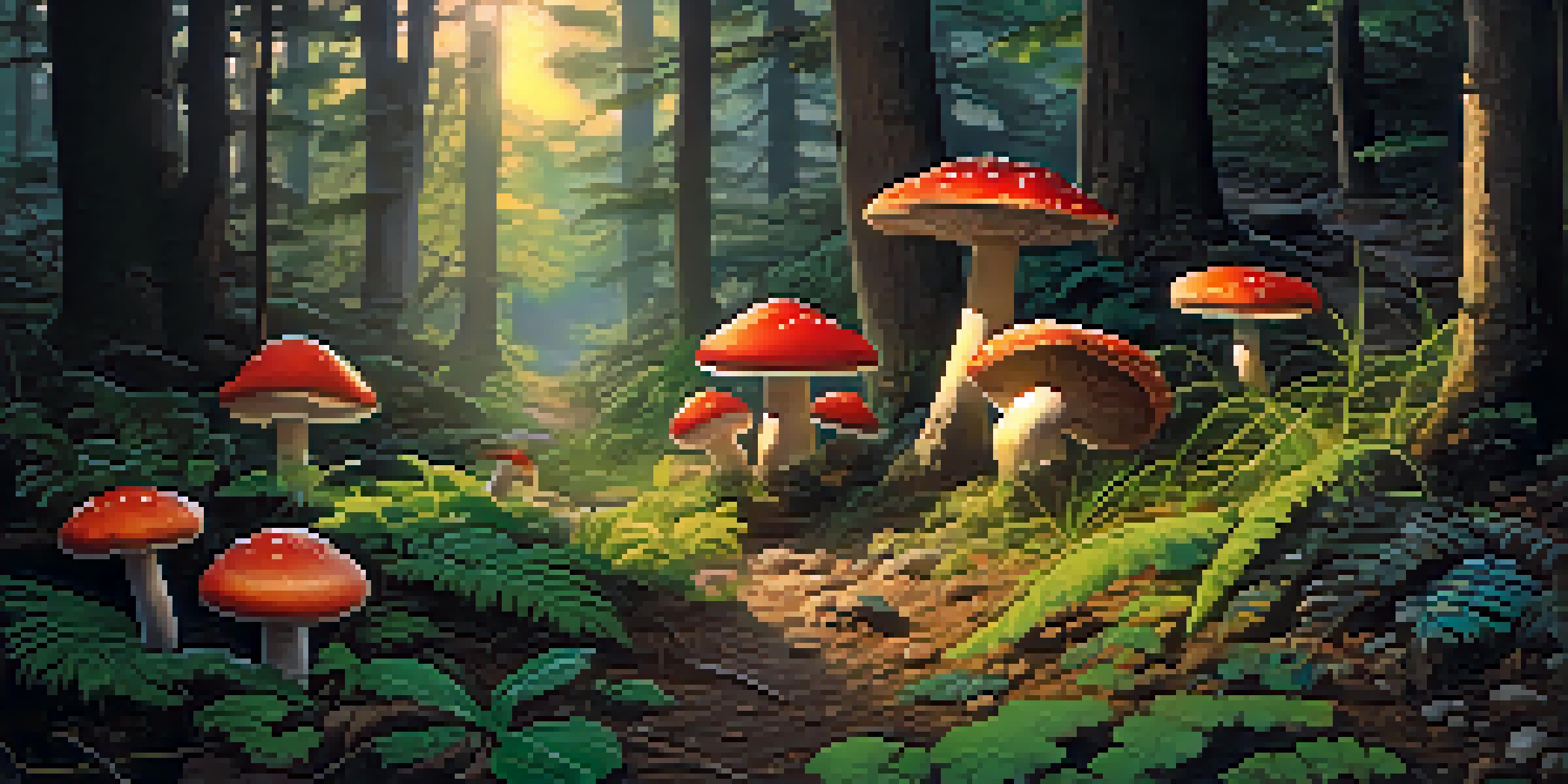Entheogens and the Nuances of Language in Social Interactions

What Are Entheogens and Their Purpose in Culture?
Entheogens are substances that can enhance spiritual experiences, often used in various cultural rituals. They have been utilized for centuries across different societies to facilitate a deeper understanding of the self and the universe. Common examples include psilocybin mushrooms and ayahuasca, which are believed to connect users with a higher consciousness or divine presence.
The experience of entheogens is often described as a journey into the depths of the self, where language becomes a bridge to understanding our shared humanity.
These substances often play a crucial role in community bonding, helping individuals break down personal barriers and connect on a more profound level. As participants share their experiences, language becomes a tool for expressing complex emotions and insights that might otherwise remain unspoken. This opens up avenues for deeper understanding and empathy between individuals.
However, the use of entheogens is not without controversy. Many cultures face stigmas or legal restrictions surrounding these substances, leading to a complex dialogue about their place in society. Understanding the cultural context of entheogens can enrich our appreciation of their significance in social interactions.
The Role of Language in Shaping Perception
Language is not just a means of communication; it shapes how we perceive our experiences. When individuals consume entheogens, their altered state of consciousness can lead to unique linguistic expressions that reflect their heightened awareness. This transformation can challenge conventional language norms, creating new ways to articulate feelings and thoughts.

For instance, a person under the influence of entheogens might describe a visual experience using metaphors or poetic language that transcends everyday vocabulary. This enriched language can foster deeper connections among participants, as they explore the nuances of their experiences together. It’s like adding colors to a black-and-white painting—suddenly, everything feels more vibrant and interconnected.
Entheogens Enhance Spiritual Connection
Entheogens facilitate deeper understanding and community bonding through shared spiritual experiences.
Moreover, the shared language developed during these experiences can reinforce community bonds. When individuals use specific terms or references that stem from their entheogenic experiences, it creates a sense of belonging and shared understanding. Over time, this specialized language can evolve within a community, making it a vital part of their identity.
Nuanced Communication: Beyond Words
Communication involves more than just spoken words; non-verbal cues play a crucial role in how we connect with others. In entheogenic settings, participants often become more attuned to body language, tone, and energy levels, enhancing their ability to communicate without words. This heightened sensitivity can lead to a richer interaction experience.
Language is the roadmap of a culture. It tells you where its people come from and where they are going.
For example, someone may not need to say they are feeling joyful; their radiant smile and open posture can convey that emotion beautifully. As people engage in these non-verbal exchanges, they can often feel a profound sense of unity, as if they are sharing a collective consciousness. This demonstrates how entheogens can deepen our understanding of communication.
However, this nuanced communication can also lead to misunderstandings if not everyone is on the same wavelength. Some individuals may interpret non-verbal cues differently based on personal experiences or cultural backgrounds. This highlights the importance of being mindful and open during social interactions, ensuring that everyone feels included and understood.
Cultural Context Influences Language Use
The cultural background of individuals significantly impacts how they express themselves, especially in altered states of consciousness. Language is steeped in cultural nuances that inform word choice and communication styles. When engaging with entheogens, these cultural contexts can influence how experiences are articulated and shared, creating a rich tapestry of expression.
For instance, in some indigenous cultures, there are specific terms and rituals associated with entheogenic use that might not exist in Western contexts. This creates a challenge for individuals from different backgrounds to fully grasp the depth of experiences being shared. Bridging these cultural gaps requires patience and a willingness to learn from one another.
Language Shapes Altered Experiences
The use of entheogens can lead to unique linguistic expressions that enhance communication and connection among participants.
Moreover, as entheogens gain popularity in different societies, new linguistic expressions may emerge. This blending of cultures can lead to a unique lexicon that incorporates elements from both traditional practices and contemporary interpretations. Observing this evolution can offer insights into how language adapts to new experiences and societal changes.
Empathy and Understanding Through Shared Experiences
Entheogens often facilitate profound moments of empathy and understanding among participants. As individuals share their journeys, they can resonate with one another’s experiences, creating a sense of solidarity. This shared vulnerability can lead to deeper conversations, where language becomes a tool for exploring complex emotions like fear, joy, and love.
For example, during a group ceremony, participants may discuss feelings of interconnectedness that arise during their experiences. They might find comfort in knowing that others have navigated similar emotional landscapes, which can profoundly impact their relationships outside of the entheogenic experience. This shared language of empathy can strengthen community ties and foster support networks.
However, it's essential to approach these discussions with care. Not everyone may feel comfortable sharing their experiences, and respecting boundaries is key. By creating an inclusive environment where everyone feels safe, the potential for meaningful conversations can flourish, allowing empathy to deepen within the group.
Challenges in Communication During Altered States
While entheogens can enhance communication, they can also present challenges. The altered state of consciousness may lead to difficulties in articulating thoughts or feelings clearly. Participants might struggle to find the right words, leading to frustration or miscommunication, which can dampen the intended connection.
For instance, someone might feel an overwhelming surge of emotion but find it hard to express that in a way that others can understand. This disconnect can create feelings of isolation, even in a group setting. Acknowledging these challenges is crucial for fostering a supportive environment where individuals can feel safe to express themselves, even if their words falter.
Cultural Context Influences Expression
Cultural backgrounds significantly affect how individuals articulate their experiences with entheogens, creating diverse expressions.
Furthermore, the variability of entheogenic experiences can result in differing perspectives within a group. What resonates deeply with one person may not hold the same weight for another. Encouraging open dialogue and patience during these moments can help bridge these gaps, allowing for more meaningful exchanges despite the hurdles.
The Future of Entheogens and Language in Society
As society's perception of entheogens continues to evolve, so too will the language surrounding their use. Ongoing research and open discussions about the benefits and challenges of these substances may lead to a broader acceptance within mainstream culture. This shift could foster new opportunities for individuals to explore their spiritual and emotional landscapes more openly.
With this change, we can expect to see a diversification of language and expression around entheogenic experiences. Communities may begin to develop their own terminologies and frameworks for discussing these journeys, enriching the dialogue and understanding. As people come together to share their insights, the collective knowledge can create a more profound understanding of the human experience.

Ultimately, the intersection of entheogens and language in social interactions holds immense potential. By embracing the nuances of communication and fostering empathy, society can create spaces where individuals feel empowered to share their experiences openly. This journey toward understanding can lead to deeper connections, both personally and collectively.